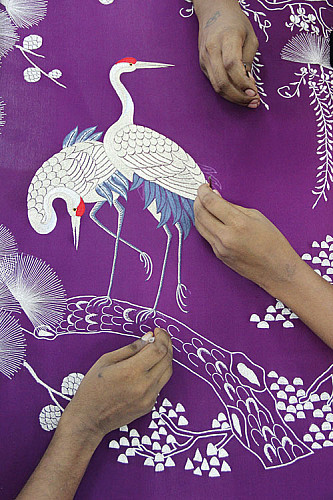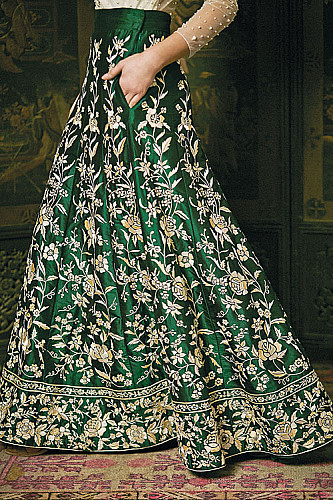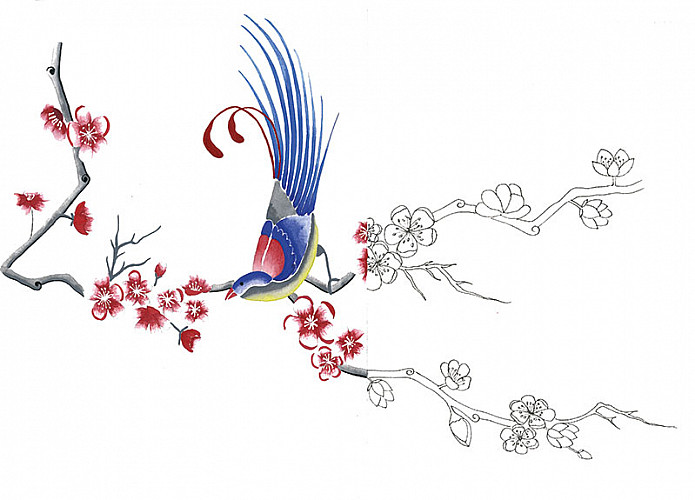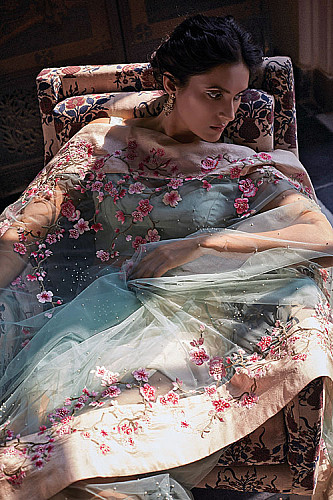Discover The Chinese Roots Of This Parsi Embroidery
Chinese Roots And Silk Routes
“People tend to forget that it is not just a craft, but also a visual identifier of the Zoroastrian community and its achievements,” says Ashdeen Z. Lilaowala of eponymous label Ashdeen, who has been working for over a decade to contemporise the Parsi gara.
It was the best of times for the Parsis in the 19th century, when men travelled from India to the Far East to trade in opium, returning home with artistically embroidered, hand-spun silk as gifts for women. Such were the beginnings of gara, which today is the community’s most striking inheritance. Dipping into its backstory, New Delhi-based Lilaowala says, “It is not as black and white as it is made out to be because there was a lot of cultural exchange that transpired. While Parsis did go to China during the Raj, there was also a lot of refining of the craft that took place in India. For example, they chose to adapt it, not for Chinese gowns or European clothes, but the sari. Also, Parsis had wealth coming in from trade and they wanted to create an identity for themselves.”
The Birds and the Trees
Besides being an Indo-China hybrid, the embroidery is multicultural in form. While inspiration from the Orient resulted in motifs such as the china-chini (Chinese man and woman), divine fungus, weeping willows, pagodas and cranes, its Indian influences took the shape of peacocks and lotuses. Persian designs were also ubiquitous via the paisley, gul-e-bulbul and simurgh (bird of paradise) as were the British symbols of baskets, bows and scallops. Given the community’s binding relationship with nature, floral motifs too adorn almost all saris, as do religious ones such as the fish and rooster. Lilaowala’s clothes and accessories are replete with chrysanthemums, peonies, roses and cherry blossoms, addressing the deep reverance for nature among Zoroastrians.
Knots and Know-how
Asal na garas or authentic garas came strictly in hues of purple, maroon and navy and were ornately embroidered with silk floss (mainly in ivory), which lent the embroidery its subtle sheen. Famously described as ‘painting with a needle’, the technique employed the satin stitch, aari or mochi stitch, petit point stitch and the devastatingly intricate French knots or khakha stitch. Even though Lilaowala uses khakha in his designs, he restricts its application to certain elements because “it doesn’t make commercial sense to use it to make full borders — it would be too expensive”. Depending on the elaborateness of the design and type of sari, a hand-stitched gara could take between two to nine months to create, which is also why they are considered heirloom-worthy.
Painstaking as the stitching may be and time-consuming though the process, Lilaowala insists that the real challenge lies in training the craftspeople. “What’s most difficult is getting them to understand what the embroidery is all about, because it is very figurative. It’s about creating exact forms and figures. And then of course, retaining the artisans. Losing good talent is always a concern,” he states.
Contemporary Canvases
Today, the gara is conspicuous in its presence at Parsi weddings and navjotes (Zoroastrian investiture ceremony), but that hasn’t always been the case. While the craft enjoyed its heyday from the 1850s to the 1920s, its popularity declined in the 1930s due to the communist upheavals in China and the khadi movement in India. Almost 50 years later, the late Naju Daver pioneered its revival. More recently, the New Delhi-based UNESCO Parzor Foundation has been making commendable efforts to bring back the lost glory of the embroidery while online apparel retailer Patine has been giving the technique a modern twist via its blouses, jackets and dresses in silk chiffon and georgette fabrics. Lilaowala, too, has expanded its application to lehngas, tunics, shawls and clutches in contemporary hues of turquoise, emerald, lime green and fuchsia, even experimenting with net. While many dispute this dilution, the designer reasons, “The fact is that the craft grew from an amalgam; it wasn’t something that existed since the beginning of time. So who is to define what an original gara is? I have no issues with machine-made versions as I believe that there is a place for everything. The most important thing is keeping the aesthetic intact.”
Despite fewer people investing in handcrafted garas because of the staggering prices they command, Lilaowala maintains that, “The main thing is patronage, and people are slowly developing an appreciation and realising that it is all about hand work. And so, I have no doubts that it will live on.”
Care For Your Wear
“The best way to look after your garas is to wear them! It is a disservice to let them lie idle. In between wears, periodically air your garment to allow the fabric to breathe.”
Related posts from Verve:
Verve Trending
Sorry. No data so far.
us on Facebook to stay updated with the latest trends









